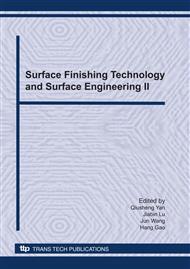p.1
p.7
p.13
p.18
p.24
p.30
p.36
p.41
Ultra Smooth Planarization Polishing Technique Based on the Cluster Magnetorheological Effect
Abstract:
A new planarization polishing method based on the cluster magnetorheological (MR) effect is presented to polish optical glass in this paper. Some process experiments were conducted to reveal the influence of the content of carbonyl iron and the abrasive materials in the MR fluid on the machining effect, and the machining characteristic of polished surface was studied. The results indicate that the surface roughness of the polished workpiece can be reduced rapidly when the strong magnetic field is applied, and ultra smooth surface with Ra 1.4 nm can be achieved while the CeO2 abrasives are used in the MR fluid. The content of carbonyl iron obviously influences the machining effect of this planarization polishing method based on cluster MR-effect. With the increase of the content of carbonyl iron in the MR fluid, the material removal rate improves and the surface roughness reduces rapidly. However, the difference of abrasive material results in various machining effects. As for the K9 optical glass, the CeO2 abrasive is better polishing abrasive than the SiC abrasive in the planarization polishing technique based on the cluster MR-effect.
Info:
Periodical:
Pages:
18-23
Citation:
Online since:
October 2010
Authors:
Keywords:
Price:
Сopyright:
© 2010 Trans Tech Publications Ltd. All Rights Reserved
Share:
Citation:


